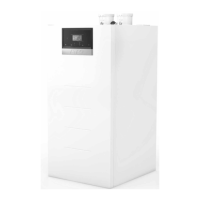29
Installation
Water and hydraulic system
Heating water quality
Fill the installation with
drinking water.
In most cases, a central heating
LQVWDOODWLRQFDQEH¿OOHGZLWKZDWHU
according to the nationally valid
regulations, whereby a treatment of the
water is not necessary.
To avoid problems, the quality of
WKH¿OOLQJZDWHUPXVWPHHWWKH
requirements in Table 1.
,IWKH¿OOLQJZDWHUVKRXOGQRWPHHW
these requirements, then it is
recommended to treat the water
correspondingly (see VDI2035).
Warranty claims become invalid if the
V\VWHPKDVQRWEHHQÀXVKHGGXULQJ
LQVWDOODWLRQRULIWKH¿OOLQJZDWHUTXDOLW\
does not meet the requirements (see
Table 1).
If anything should not be clear, or in
case of deviations, always get in touch
ZLWK$7$*¿UVW7KHZDUUDQWLHVODSVHLI
any changes are made without an prior
agreement/release by .
Installation:
- The use of groundwater,
demineralized water and distilled
water, is not permitted (an
explanation of these terms can be
found on the next page).
- If the drinking water quality lies
within the limits of the values in
Table 1, then one can proceed
with the installation of the
V\VWHPDQGWKHÀXVKLQJRIWKH
equipment.
- Residues of corrosion products
(magnetite), assembly materials,
cutting oil and other undesirable
products, must be removed during
WKHÀXVKLQJRSHUDWLRQ
- Another possibility for removing
GLUWLVWKHXVHRID¿OWHU7KH¿OWHU
W\SHPXVWPHHWWKHV\VWHPVSHFL¿F
requirements and the type of
contamination. ATAG recommends
WKHXVHRID¿OWHU
In such a case, one should make
sure to take the entire system into
consideration.
- The central heating installation must
be de-aerated properly, before it is
taken into operation. Please check
the Chapter “Commissioning”
in this regard.
- If a regular topping up of water
is required (> 5% per year), then
there is a problem with the system
WKDWPXVWEHUHFWL¿HGE\DFHUWL¿HG
technician. Regular topping up
with fresh water adds oxygen and
lime to the system, which leads
to deposits.
- If an anti-freeze agent or other
additives are used, then it must be
regularly checked to ensure that the
¿OOLQJZDWHUTXDOLW\PHHWWKH$7$*
requirements.
- Inhibitors may only be used after
consultation with ATAG.
- The use of such agents must be
protocolled.
Floor heating
:KHQDÀRRUKHDWLQJV\VWHPLV
connected that uses plastic pipes,
it must be ensured that it meet the
standard DIN 4726-4729. If the system
GRHVQRWIXO¿OWKHVWDQGDUGWKHQD
system separation must be used.
If the regulations with regard to
SODVWLFSLSLQJDUHQRWPHWWKHQ
warranty claims become null and
void (see the warranty conditions).
Parameters Value
Water type Drinking water
Softened water
pH 6.0-8.5
Conductivity (at 20°C in μS/cm) Max. 2500
Iron (ppm) Max. 0.2
Hardness (°dH / °fH)
Installation volume/performance
<20 l/kW
1-12
Installation volume/performance
>=20 l/kW
1-7
Oxygen 2[\JHQGLႇXVLRQLVQRWSHUPLWWHGGXULQJRSHUDWLRQV
Max. 5% of the system volumes may be topped up annually.
Corrosion inhibitors See the Chapter "System water additives (inhibitors)"
pH raising or lowering agents See the Chapter "System water additives"
Anti-frost additives See the Chapter "System water additives"
Other chemical additives See the Chapter "System water additives"
Solid substances Not permitted
Residues in the heating water, which are not a component of
the drinking water are
Not permitted
Table 1

